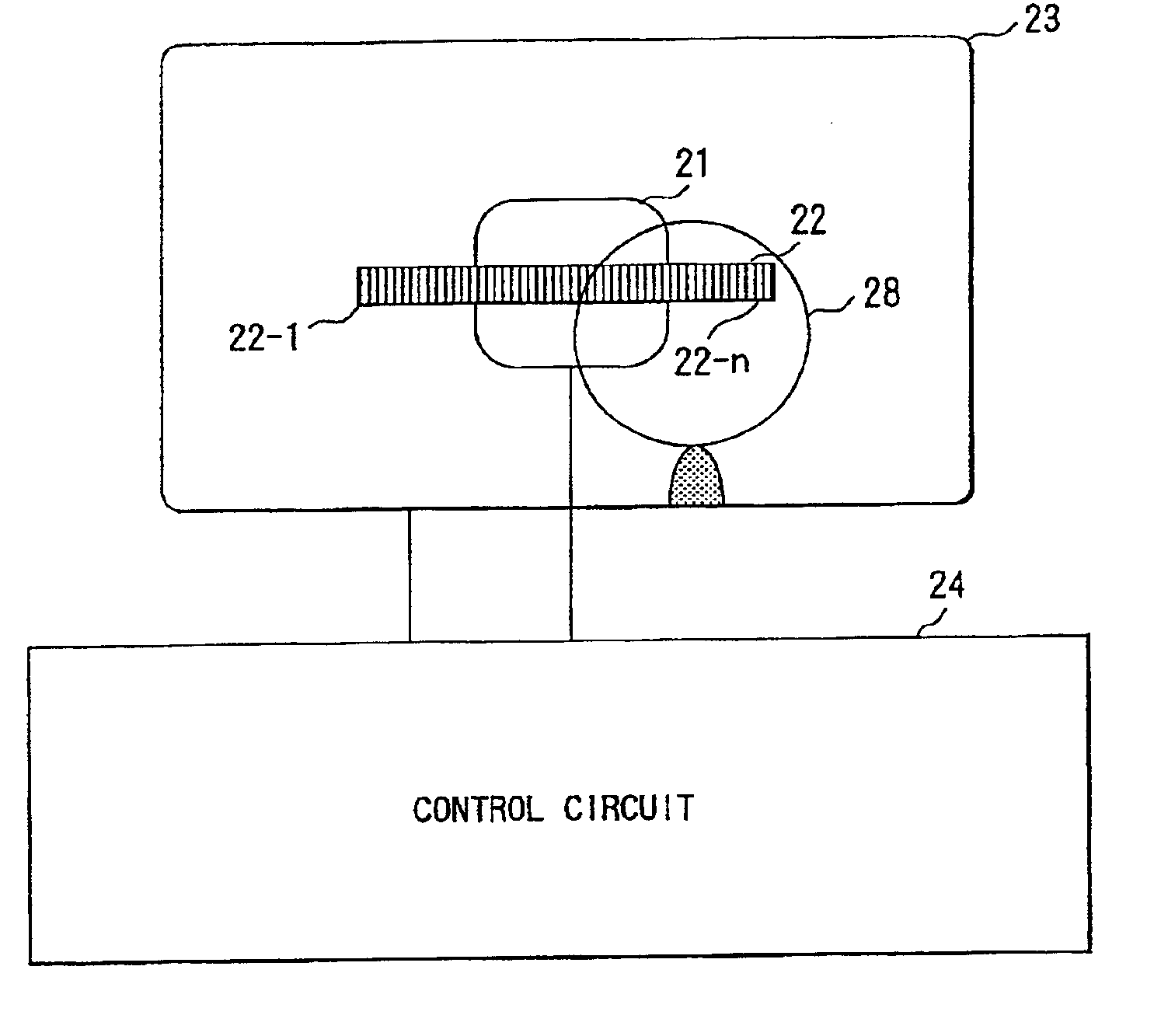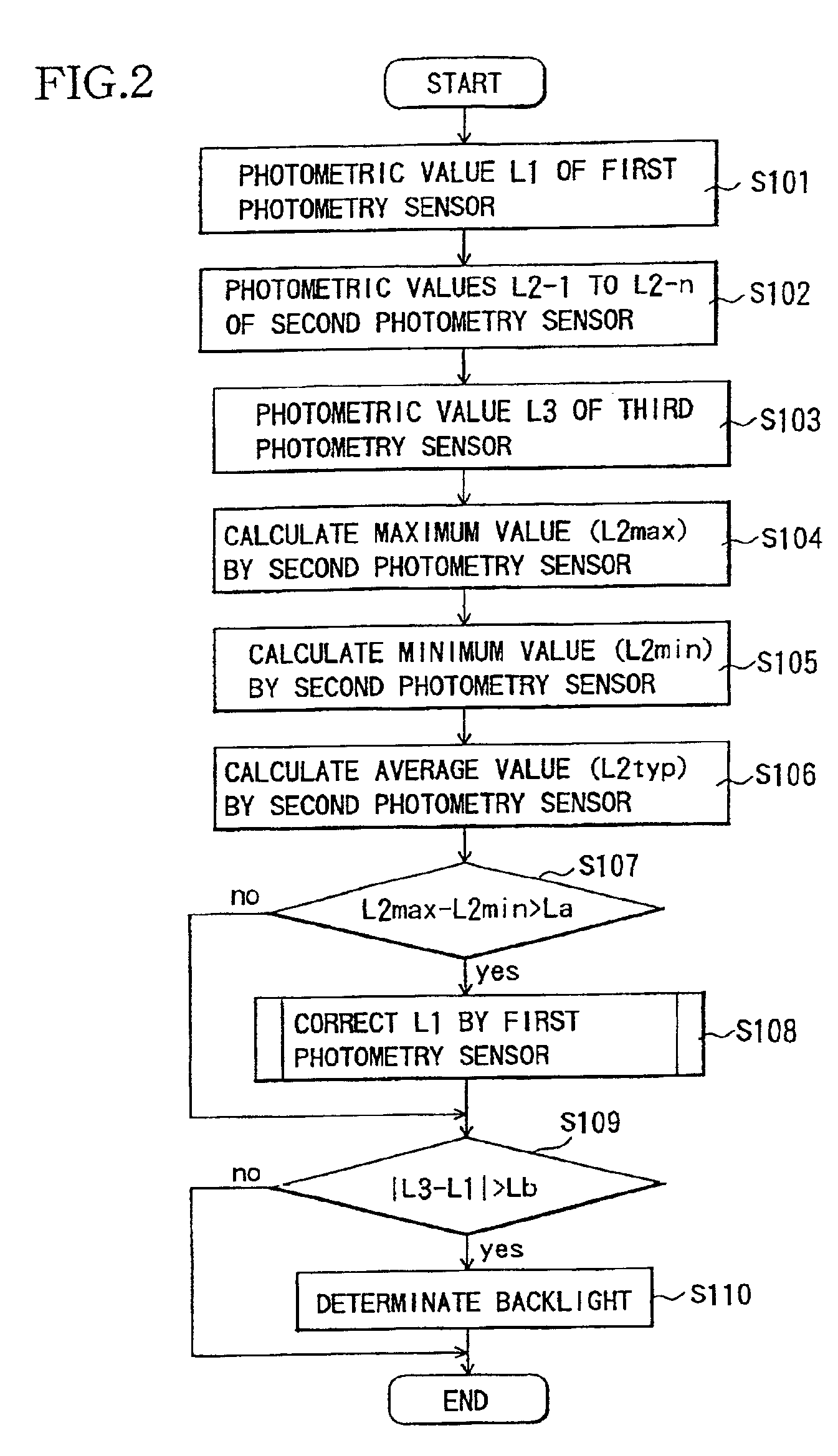Photometric device and camera
- Summary
- Abstract
- Description
- Claims
- Application Information
AI Technical Summary
Benefits of technology
Problems solved by technology
Method used
Image
Examples
first embodiment
(First Embodiment)
[0042]FIG. 1 illustrates the configuration of a photometric device according to a first embodiment of the present invention. It should be noted that description will be made herein assuming that the photometric device is provided for a camera (film camera, digital camera, video camera or the like).
[0043]In FIG. 1, reference numeral 1 refers to a first photometric sensor for performing photometry in a specific area (predetermined area: a central area of a picture in the first embodiment) of a picture. Reference numeral 2 refers to a second photometric sensor consisting of a group of small sensors (photoelectric conversion elements) 2-1, 2-2, . . . , 2-n for performing photometry in a plurality of subareas formed by dividing some or all of the specific area.
[0044]Reference numeral 3 refers to a third photometric sensor for performing photometry in a peripheral area around the specific area. Reference numeral 4 refers to a control circuit connected to the first photom...
second embodiment
(Second Embodiment)
[0063]FIG. 3 shows a flow chart illustrating the operation of a photometric device according to a second embodiment of the present invention. The configuration of the photometric device in the second embodiment is identical to that in the first embodiment.
[0064]First, a control circuit 4 sends a control signal to a first photometric sensor 1 to cause it to perform photometry in a specific area, and then obtains a photometric value L1 thereof (S201).
[0065]Subsequently, the control circuit 4 sends a control signal to a group of sensors 2-1, 2-2, . . . , 2-n constituting a second photometric sensor 2 to cause them to perform photometry in respective subareas, and then obtains photometric values L2-1 to L2-n thereof (S202).
[0066]The control circuit 4 sends a control signal to a third photometric sensor 3 to cause it to perform photometry in a peripheral area, and then obtains a photometric value L3 thereof (S203).
[0067]Next, the control circuit 4 makes calculations to...
third embodiment
(Third Embodiment)
[0081]FIG. 4 illustrates the configuration of a photometric device according to a third embodiment of the present invention. It should be noted that description will be made herein assuming that the photometric device is provided for a camera.
[0082]In FIG. 4, reference numeral 12 refers to a group of photoelectric conversion elements (photometric sensors) arranged all over a photographic area, in which the individual photoelectric conversion elements are designated by reference numerals of 2-1 to 2-n.
[0083]Reference numeral 11 refers to photoelectric conversion elements 2-i to 2-j which are included in a specific area of the picture (predetermined area: an area surrounded by a black bold line in a central portion of the picture) and are called herein a first photometric sensor group. In the third embodiment, as later described, the sum of photocurrents from the photoelectric conversion elements 2-i, . . . , 2-j constituting the first photometric sensor group 11 is ...
PUM
 Login to View More
Login to View More Abstract
Description
Claims
Application Information
 Login to View More
Login to View More - R&D
- Intellectual Property
- Life Sciences
- Materials
- Tech Scout
- Unparalleled Data Quality
- Higher Quality Content
- 60% Fewer Hallucinations
Browse by: Latest US Patents, China's latest patents, Technical Efficacy Thesaurus, Application Domain, Technology Topic, Popular Technical Reports.
© 2025 PatSnap. All rights reserved.Legal|Privacy policy|Modern Slavery Act Transparency Statement|Sitemap|About US| Contact US: help@patsnap.com



